Church Starts Building, With Blessing
Nearly every Sunday morning for a decade, Glenn Kirby has preached in a rented elementary school auditorium and exhorted worshipers to believe that one day they would raise an edifice of their own.
That vision appeared to come into sharp focus Sunday as Kirby’s 400-member congregation broke ground for the $10-million West Valley Christian Church and Schools at the former site of the Trafficanda Egg Ranch in West Hills.
While neighbors of the ranch on Sherman Way at Shoup Avenue fought other development plans for the site--including a self-storage facility, an apartment complex and two-story townhomes--they gave the church and school project their blessing.
Neighbors said that’s because the church involved residents in the planning process long before it purchased the property or requested land-use permits from the city.
“It’s a miracle,” said Kirby, the senior minister of the West Hills congregation. “This is a cooperative effort between the seller, neighbors, city officials and the church and school.”
The stakes were high for everyone involved. Residents opposed any development that would bring traffic and noise to their neighborhood. West Valley Christian was forced to find a new home for its church and schools after the Los Angeles Unified School District announced in January that it would not renew the church’s leases at the former Enadia Way and Highlander Road elementary schools in West Hills. And Trafficanda Egg Ranch was desperate for a buyer after three previous deals collapsed because of neighborhood opposition.
For the Trafficandas, the property has been a family heirloom for decades.
In 1954, Joe and Marie Trafficanda began the ranch, which featured clucking chickens that laid eggs right before customers’ eyes. Profits from egg sales helped the Trafficandas raise four children, who became equal partners in the business after their parents died.
Today, the chickens are gone and the operation has moved to Van Nuys, where other ranchers drop off their eggs for the Trafficandas to distribute to retail outlets.
The younger generation put the 2.5-acre property on the market more than two years ago.
For area residents, the proposals that came in to build multifamily housing and storage facilities only meant adding more brick and mortar to an area that was once the province of horse ranches, dairy farms and citrus groves.
As word spread throughout the community in July 2000 that the Trafficandas were seeking a variance to build a 1,200-unit storage facility on the parcel, which is zoned for agricultural use, a loosely organized group of homeowners banded together to fight that plan and later ones.
“The developers’ way of doing things is that they come in and tell you what they have to have,” said Ray Price, a leader of the homeowners’ group. “Then they get their high-powered attorneys to tell you, ‘This is the way we are going to do it.’ It’s a David and Goliath case from the beginning.”
For West Valley Christian, the reality that the congregation could be without a home when the church’s leases expired on July 1, 2003, lit a fire under a group that had been looking for a permanent facility off and on for 10 years, Kirby said.
West Valley Christian had considered a 2.5-acre property owned by another church next to the egg ranch, Kirby said, but dropped out of escrow when West Valley Christian leaders agreed that the property was too small to meet their needs.
The Trafficandas then acquired the church property next to their ranch and put the entire 5-acre parcel on the market last fall.
“One of the neighbors told us about the 5 acres that were available and that we should try to get them,” Kirby said.
But before approaching the Trafficandas, Kirby said, a church committee met with neighborhood leaders, who then endorsed the preliminary plan. They continued to meet regularly throughout the 10 months it took to close the deal.
“The big difference is that Glenn came into our neighborhood with an open mind and a willingness to compromise,” Price said. “His attitude was, ‘How can we make this project neighborhood-friendly?’ This was a textbook case of how a developer should come into a neighborhood and work with everyone.”
The Trafficandas said they were pleased with the sale. “It’s a good outcome,” said Paul Trafficanda, a family spokesman. “The church and school will be good for the neighborhood.”
As for Kirby and his congregation, they have been rejoicing since late last week when the sale cleared escrow. The project, to be built in three phases, will include a 500-seat sanctuary, administrative offices, a gymnasium and classroom buildings for 500 students in preschool through 12th grade.
The first phase--which will include construction of a 20,000-square-foot education building with classrooms, offices and restrooms and the remodeling of an existing 200-seat church--is expected to be completed by July 1.
More to Read
Sign up for Essential California
The most important California stories and recommendations in your inbox every morning.
You may occasionally receive promotional content from the Los Angeles Times.










